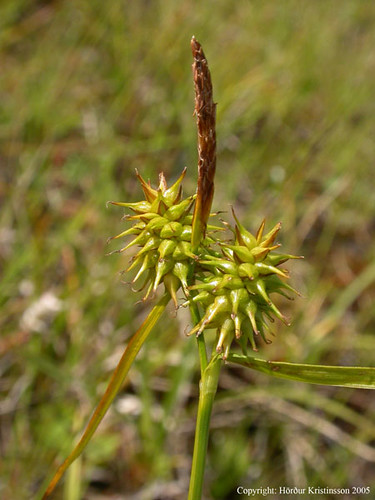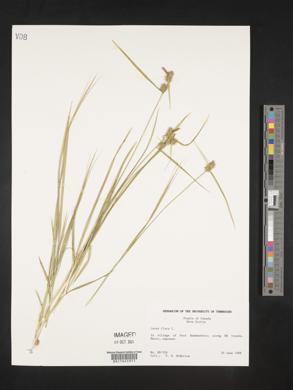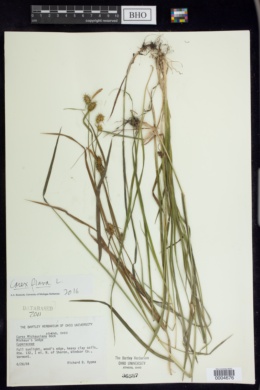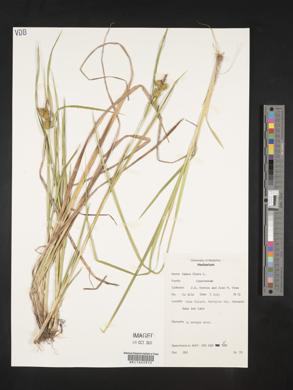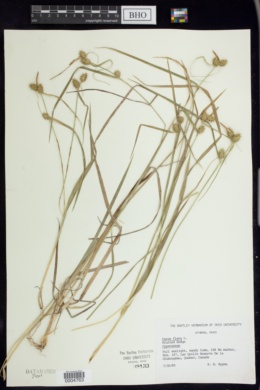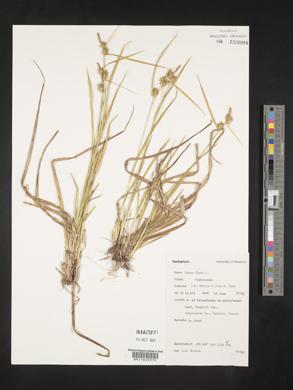Carex flava
|
|
|
|
Family: Cyperaceae
Yellow-Green Sedge
[Carex flava var. fertilis Peck, moreCarex flava var. gaspensis Fernald, Carex flava var. graminis Bailey, Carex flava var. laxior (Kük.) Gleason, Carex flava var. rectirostra , Carex flava var. uetliaca (Suter) Nyman, Carex flava var. vulgaris Döll, Carex lepidocarpa var. laxior Kük., Carex nevadensis subsp. flavella] |
Plants cespitose. Culms straight, 10-75 cm. Leaves of flowering stems shorter than to slightly exceeding culms, 5-30 cm × 1.6-4.7(-5.8) mm; ligules on distal cauline leaves truncate or rounded. Inflorescences: peduncles of terminal spikes 0.4-5(-9) mm; bracts to 18.5 cm × (0.7-)2-4.5 mm; inner band of sheaths truncate or concave. Spikes: proximal pistillate spikes (1-)2-5, contiguous or approximate, globose to elliptic, 8-22 × 7.5-12.7 mm; terminal staminate spikes sessile or pedunculate, 9-22 × 1.1-3 mm. Scales: pistillate scales reddish brown, 2.3-3.9 × 0.9-1.4 mm; staminate scales reddish brown, ovate, margins narrowly whitish hyaline, apex obtuse. Anthers 1-2.1 mm. Perigynia reflexed, bright yellow at maturity, 4-6.3 × 1-1.9 mm, apex gradually narrowed; beak 1.3-2.7 mm, forming angle of (15-)26-72° with body, scabrous. Achenes 1.3-1.7 × 0.9-1.2 mm. 2n = 60. Fruiting Jun-Aug. Moist to wet habitats, such as open meadows, fens, partially shaded shrub carrs, swamps, on lime-rich soils; 0-2000 m; St. Pierre and Miquelon; Alta., B.C., Man., N.B., Nfld. and Labr., N.S., Nunavut, Ont., P.E.I., Que.; Alaska, Conn., Idaho, Ind., Maine, Mass., Mich., Minn., Mont., N.H., N.J., N.Y., Ohio, Pa., R.I., Vt., Wis.; Europe; Asia (Iran). Tufted, 1-8 dm; lvs flat, mostly 3-5.5 mm wide, the plants appearing leafier than no. 153 [Carex viridula Michx.]; terminal spike sessile or short-pedunculate, slender, staminate or with some distal perigynia, 6-24 mm; lateral spikes 2-5, pistillate, short and stout, 6-17 mm, all sessile or short-pedunculate and crowded at the summit, or 1 or 2 of the lower ±remote and more evidently pedunculate; bracts sheathless or nearly so (except those subtending any remote spikes), one or more of them with an elongate blade much surpassing the infl; pistillate scales strongly tinged with coppery brown, thus conspicuous in the spike; perigynia 3.7-6.2 mm, most of them spreading and evidently falcate-recurved, relatively slender and gradually tapering to the poorly defined, distally rough-margined beak, this 1.4-2.3 mm, set at a ±divergent angle to the body; perigynium-body strongly yellowish toward the base, usually more greenish (or eventually brownish) distally, prominently several-nerved on the upper surface, more obscurely so on the lower, achene hardly larger than in no. 153, a larger part of the perigynium thus empty; 2n=60, 64, 68, 70. Bogs and wet meadows in calcareous districts; circumboreal, s. in Amer. to N.J., Ind., Ida., and B.C. (C. laxior) Gleason, Henry A. & Cronquist, Arthur J. 1991. Manual of vascular plants of northeastern United States and adjacent Canada. lxxv + 910 pp. ©The New York Botanical Garden. All rights reserved. Used by permission. From Flora of Indiana (1940) by Charles C. Deam A widespread species which is common throughout most of its range but rare and very local in Indiana. The two known localities for it in the state are: marly marsh on the Wolverton Estate, 7 miles southwest of South Bend, St. Joseph County, Deam nos. 54874 and 55079; and springy wooded bank of Flat Rock River, three-fourths of a mile above St. Paul, Decatur County, Mrs. C. C. Deam nos. 10766 and 13400. ...... Indiana Coefficient of Conservatism: C = 10 Wetland Indicator Status: OBL |

